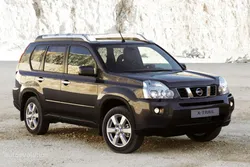

Nissan X-Trail Generation 2 Facelift 2010 Review
Explore the Nissan X-Trail, focusing on the Generation 2 Facelift 2010 model. Discover its features, specifications, and performance in Portugal.
The Nissan X-Trail has long been a staple in the compact SUV market, offering a blend of practicality, reliability, and off-road capability. The second generation of the X-Trail, which debuted in 2007...
Technical Specifications
Select Version
Dimensions
Engine
Driving
Others
History and Features
Mycarro AI
Apr 27, 2025
The Nissan X-Trail has long been a staple in the compact SUV market, offering a blend of practicality, reliability, and off-road capability. The second generation of the X-Trail, which debuted in 2007, received a significant facelift in 2010. This update aimed to enhance both the aesthetic appeal and the overall performance of the vehicle, catering to a growing demand for premium features among compact SUV buyers.
Design Enhancements
One of the most noticeable changes in the 2010 facelift was the updated exterior design. The revised front fascia featured a more aggressive stance with a redesigned grille and headlight assembly. The headlights received a sleeker, more contemporary shape that flowed seamlessly into the lines of the hood, giving the X-Trail a modern look. The rear of the vehicle also saw subtle tweaks, including updated taillights that provided a sharper and more sophisticated appearance. The overall body design was also refined, resulting in better aerodynamics, which contributed to improved fuel efficiency.
Interior Comfort and Features
Inside, the 2010 facelift of the Nissan X-Trail brought a host of upgrades aimed at enhancing passenger comfort and convenience. The cabin featured improved materials, creating a more upscale environment compared to its predecessor. The dashboard received a redesigned layout that was easier to navigate, with an intuitive center console housing a variety of advanced technology features. Notable additions included a refined infotainment system, Bluetooth connectivity, and premium audio options, making the driving experience more enjoyable.
Safety Innovations
Safety was a prominent focus during the facelift of the Nissan X-Trail. The 2010 model incorporated several cutting-edge safety features to elevate the vehicle's performance in crash tests. Enhancements included an upgraded anti-lock braking system (ABS) with electronic brakeforce distribution (EBD), stability control, and an array of airbags. These innovations were crucial in meeting stringent safety standards and promoting buyer confidence. The X-Trail was equipped with advanced technologies such as a rearview camera and parking assistance features, making it easier for drivers to navigate urban environments.
Engine Options and Performance
Under the hood, the facelifted X-Trail offered various engine options, catering to a wide range of customer preferences. The primary engines consisted of efficient petrol and diesel variants, designed to provide a balance between power and fuel efficiency. The 2.0-liter petrol engine delivered a smooth driving experience and adequate performance for day-to-day commuting, while the 2.0-liter diesel engine appealed to those seeking better fuel economy and towing capabilities. The 2010 facelift also saw the introduction of an updated continuously variable transmission (CVT), which aided in providing responsive acceleration and improved fuel efficiency.
All-Wheel Drive Capability
Nissan's reputation for producing capable SUVs was further emphasized in the X-Trail's 2010 facelift with its all-wheel-drive (AWD) system. This feature provided drivers with enhanced traction and stability, allowing them to confidently navigate various terrains, whether on city streets, rural roads, or light off-road conditions. The intelligent system monitored wheel slip and adjusted power distribution accordingly, promoting excellent handling and control in changing weather conditions.
Market Reception and Legacy
The 2010 facelift of the Nissan X-Trail was met with positive reception from both critics and consumers alike. Buyers praised its balance of comfort, versatility, and capabilities. The enhanced design and safety features were particularly noted, positioning the model as a competitive contender in the compact SUV segment. Over the years, the X-Trail has maintained its status as a popular choice among families and adventure-seekers, with the 2010 facelift solidifying its legacy as a reliable and stylish option.
Conclusion
In conclusion, the Nissan X-Trail Generation 2 (Facelift 2010) serves as a testament to Nissan's commitment to producing vehicles that meet the evolving demands of the market. With its refined design, improved interior features, comprehensive safety enhancements, and commendable performance capabilities, the facelifted X-Trail remains a well-rounded compact SUV choice. As Nissan continues to innovate, the 2010 facelift exemplifies the brand's ability to adapt to consumer expectations while retaining the core qualities that have made the X-Trail a beloved model since its inception.
